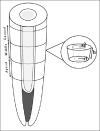Influence of irrigating agents on fiber postpush-out bond strength to radicular dentin sections with the different adhesive system
- PMID: 28932151
- PMCID: PMC5594970
- DOI: 10.4103/ejd.ejd_280_16
Influence of irrigating agents on fiber postpush-out bond strength to radicular dentin sections with the different adhesive system
Abstract
Objective: The objective of this study is to evaluate the effect of irrigating agents on push-out bond strength of resin postcemented with various adhesive systems at different radicular dentin sections.
Materials and methods: Sixty single-rooted premolar teeth were root canal treated, subsequently decorated at cementoenamel junction. The endodontic postspace was irrigated with 5.25% sodium hypochlorite (NaOCl) and 17% ethylenediaminetetraacetic acid (EDTA) for Group A (n = 30) and Group B (n = 30), respectively. The sample from each group was subdivided into three groups (10) according to luting protocol of etch-wash, self-etch, and self-adhesive. Individual teeth with cemented resin postsamples were sectioned into coronal, middle, and apical segments. Subsequently, subjected for pushout bond strength test by applying a load at 0.5 mm/min speed. The data were analyzed by three-way analysis of variance and Tukey comparison test at a significant difference level of 0.05.
Results: The coronal section with 5.25% NaOCl irrigation and self-etch luting protocol provided the highest push out strength at 16.282 Mpa. The etch-wash luting protocol in both irrigations showed the lesser bond strength at 8.273 and 8.493 MPa, respectively, in coronal section.
Conclusions: The self-etch adhesive system showed better push out bond strength and 17% EDTA had a negative influence on self-etch bond strength. The coronal sections had highest bond strength in comparison with apical radicular dentin sections.
Keywords: Composite resin cement; endodontic post; push-out bond strength.
Conflict of interest statement
There are no conflicts of interest.
Figures
Similar articles
-
Effect of Apical Root Canal Perforation Size on Push-out Bond Strength of Glass Fiber Dowels.J Contemp Dent Pract. 2020 May 1;21(5):515-520. J Contemp Dent Pract. 2020. PMID: 32690833
-
Influence of resin cements and root canal disinfection techniques on the adhesive bond strength of fibre reinforced composite post to radicular dentin.Photodiagnosis Photodyn Ther. 2021 Mar;33:102108. doi: 10.1016/j.pdpdt.2020.102108. Epub 2020 Nov 23. Photodiagnosis Photodyn Ther. 2021. PMID: 33242655
-
Photodynamic activation of irrigation (using different laser prototypes) on push out bond strength of fiber posts.Photodiagnosis Photodyn Ther. 2020 Jun;30:101716. doi: 10.1016/j.pdpdt.2020.101716. Epub 2020 Mar 9. Photodiagnosis Photodyn Ther. 2020. PMID: 32165335
-
Effect of Self-Adhesive and Separate Etch Adhesive Dual Cure Resin Cements on the Bond Strength of Fiber Post to Dentin at Different Parts of the Root.J Dent (Tehran). 2017 May;14(3):153-158. J Dent (Tehran). 2017. PMID: 29167687 Free PMC article.
-
Effect of Endodontic Irrigating Solutions on Radicular Dentine Structure and Matrix Metalloproteinases-A Comprehensive Review.Dent J (Basel). 2022 Nov 23;10(12):219. doi: 10.3390/dj10120219. Dent J (Basel). 2022. PMID: 36547035 Free PMC article. Review.
Cited by
-
In Vivo Measurement of Root Canal Wall Temperature at Different Stages Prior to Fiber Post Cementation.Eur J Dent. 2019 Feb;13(1):69-74. doi: 10.1055/s-0039-1688539. Epub 2019 Jun 6. Eur J Dent. 2019. PMID: 31170753 Free PMC article.
-
Push-Out Bond Strength of Fiber-Reinforced Post Using Various Post Space Irrigation Treatments.Int J Dent. 2024 Nov 6;2024:8647515. doi: 10.1155/2024/8647515. eCollection 2024. Int J Dent. 2024. PMID: 39545178 Free PMC article.
-
Effect of collagen crosslinkers on sodium hypochlorite treated dentin bond strength: a systematic review and meta-analysis.Front Bioeng Biotechnol. 2025 Apr 9;13:1547158. doi: 10.3389/fbioe.2025.1547158. eCollection 2025. Front Bioeng Biotechnol. 2025. PMID: 40271350 Free PMC article.
References
-
- Vichi A, Ferrari M, Davidson CL. Influence of ceramic and cement thickness on the masking of various types of opaque posts. J Prosthet Dent. 2000;83:412–7. - PubMed
-
- Jongsma LA, Kleverlaan CJ, Feilzer AJ. Influence of surface pretreatment of fiber posts on cement delamination. Dent Mater. 2010;26:901–7. - PubMed
-
- Jongsma LA, Bolhuis PB, Pallav P, Feilzer AJ, Kleverlaan CJ. Benefits of a two-step cementation procedure for prefabricated fiber posts. J Adhes Dent. 2010;12:55–62. - PubMed
-
- Malyk Y, Kaaden C, Hickel R, Ilie N. Analysis of resin tags formation in root canal dentine: A cross sectional study. Int Endod J. 2010;43:47–56. - PubMed
LinkOut - more resources
Full Text Sources
Other Literature Sources



